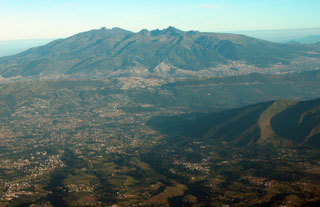Report on Guagua Pichincha (Ecuador) — September 2001
Bulletin of the Global Volcanism Network, vol. 26, no. 9 (September 2001)
Managing Editor: Richard Wunderman.
Guagua Pichincha (Ecuador) Gradual dome growth through March; ash emissions through May 2001
Please cite this report as:
Global Volcanism Program, 2001. Report on Guagua Pichincha (Ecuador) (Wunderman, R., ed.). Bulletin of the Global Volcanism Network, 26:9. Smithsonian Institution. https://doi.org/10.5479/si.GVP.BGVN200109-352020
Guagua Pichincha
Ecuador
0.171°S, 78.598°W; summit elev. 4784 m
All times are local (unless otherwise noted)
This report covers the interval from mid-January through May 2001. The previous report (BGVN 26:01) noted that a new dome ("dome 9") resulted from lava extrusions subsequent to explosions on 23 July 2000.
The volcano remained at Alert Level Yellow throughout the report period. Activity consisted principally of consistent, gradual growth of dome 9 through 26 March when the small number of rockfall signals suggested that the dome was stable. Seismicity and other volcanic activity has been moderate with small rockfalls occurring during February. The Washington Volcanic Ash Advisory Center (VAAC) reported ash emissions on 18 and 31 March, and again on 25 May; however, none of these were visible on GOES-8 imagery. The ash emission on 25 May rose to ~8.5 km altitude, the highest of those reported. A large number of long-period (LP) earthquakes also occurred during March. More than 806 LP earthquakes were registered during the week of 18-24 March but 460 of these occurred on 18 March in conjunction with the ash emission on that date.
Geological Summary. Guagua Pichincha and the older Pleistocene Rucu Pichincha stratovolcanoes form a broad volcanic massif that rises immediately W of Ecuador's capital city, Quito. A lava dome grew at the head of a 6-km-wide scarp formed during a late-Pleistocene slope failure ~50,000 years ago. Subsequent late-Pleistocene and Holocene eruptions from the central vent consisted of explosive activity with pyroclastic flows accompanied by periodic growth and destruction of the lava dome. Many minor eruptions have been recorded since the mid-1500's; the largest took place in 1660, when ash fell over a 1,000 km radius and accumulated to 30 cm depth in Quito. Pyroclastic flows and surges also occurred, primarily to then W, and affected agricultural activity.
Information Contacts: Instituto Geofísico (IG), Escuela Politécnica Nacional, Apartado 17-01-2759, Quito, Ecuador (URL: http://www.igepn.edu.ec/); Washington Volcanic Ash Advisory Center (VAAC), Satellite Analysis Branch, NOAA/NESDIS E/SP23, NOAA Science Center Room 401, 5200 Auth Road, Camp Springs, MD 20746, USA (URL: http://www.ssd.noaa.gov/).

